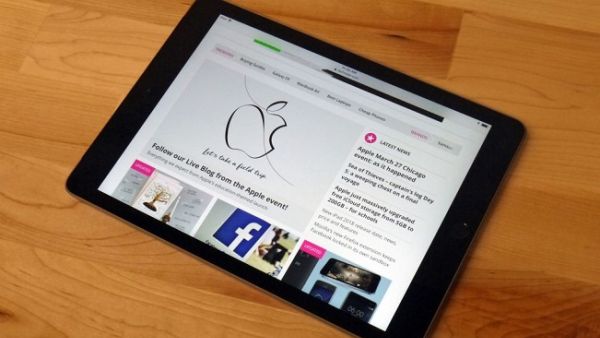The new iPad for 2018 is the latest tablet from Apple, and it's good news for both the student and the general consumer.
It’s a budget-conscious slate that’s designed to help Apple make further inroads into the lucrative education market, and as such it loses some of the key features of the top-end devices in an effort to keep the price down and make it affordable for schools and parents.
The new iPad (2018) starts at $329 / £319 / AU$469) for 32GB of storage, although it's $30 cheaper for schools (we're not sure about the discount for the UK or Australia yet). The 128GB version is $429 / £409 / AU$599. If you want cellular connectivity, that starts at $459 / £449 / AU$669 for the 32GB model.
- Facebook Data Scandal and Cambridge Analytica: What You Need to Know
- Cyber Attacks a ‘Real Threat’ to GCC Businesses: Analysts
While it maintains the same price in the US and Australia, currency fluctuations mean that in the UK the basic 32GB version is actually £20 cheaper than 2017's iPad.
This is the same shape and chassis that was used in 2017's model, but there are some key upgrades.
The Apple Pencil could be a game-changer

The main feature of the new iPad is the fact that it's Apple Pencil-compatible, something that's not been seen since the launch of the iPad Pro range. This is the first 'normal' tablet from Apple to take advantage of the accessory, and it's designed to give students a chance to ditch the notepad and use only the iPad for class.
This is an... okay move. There's nothing like the feel of pen on paper, but there's a lot to be said about having all your notes stored in one place for easy access. You're getting the ability to have your scrawl automatically recognized, but the bigger play here is being able to annotate documents directly from within Pages thanks to the update Apple has brought.
It's a neat trick, as the scrawl is locked to the point in the text where you added words with the Pencil – entering more text will see your scribblings move along too.

The scrawl will be hard to actually input though, and that's partly down to the fact that most people have forgotten how to actually write words down, and partly because the feel of the screen under the Apple Pencil still feels too slippery to write properly. If you slow down it's not too bad, but you can't note-take as fast as with a pen and notepad.
The new iPad doesn't feature the Smart Connector on the side of the tablet, but there are options to add Bluetooth keyboards, with Logitech adding some at launch.
The rest of the changes revolve around the software, with ClassKit the main focus as well as Apple's suite of education apps. This has all been linked together under the Schoolwork app, where users will be able to access content for courses, see materials from teachers, or submit assignments and get feedback from teachers.

This is a big part of what Apple is offering the classroom, and as such there's a bundle of free online storage through iCloud added in – 200GB in fact for education, although if you're buying this as a consumer you're stuck with 5GB.
In our early tests we found the apps and overall experience were as slick as you've come to expect from the brand, with everything polished and looking pretty fancy... as you'd expect given the investment in these tablets.
Sadly the Apple Pencil hasn't been dropped in price, nor does it come bundled... that would have been a smart move from Apple, but a costly one. There is a new Crayon from Logitech though, which we assume offers the same functionality, although we've yet to try it.
Design

If you've ever seen a normal iPad from Apple, then you'll know the new iPad for 2018 instantly. It's got the same metal chassis with large bezels all the way around, and the rounded corners on the back make it very comfortable to hold.
One of the ways that Apple is able to reduce the cost of devices like this is through reusing designs it's already created, and this is essentially last year's new budget iPad retooled for a lower-cost market. That means the same machined volume keys, raised camera bump on the rear, and home button (there's no gesture-based interface as you might see on the iPhone X here).
There's also a headphone jack, as we've constantly seen on the larger tablet range from Apple, showing that the decision to lose it on the phones is still just a space-saving exercise.
In the hand, the new iPad feels premium, and belies its price tag. It's something that students will want to use, and while it might not have some of the fancier features of the iPad Pro (like four amazing speakers) it functions as a decent tablet just fine.
The dual speakers at the bottom aren't as powerful, and actually in classroom environment that might not be enough... we struggled to hear our moon landing project that we were making through GarageBand, although the interactive nature is fun.
Screen

The new iPad screen is, predictably, nothing to get too excited about. The main thing about the new iPad Pro 10.5 was that it offered premium features like a True Tone display (for dynamic white balance that matched your surroundings) and ProMotion display, which gave it a slick interface thanks to the improved refresh rate.
Nothing like that here – it's just a standard 9.7-inch display with a resolution of 1536 x 2048, but that's not to say it's not perfectly usable. Like the iPad from 2017, Apple bringing its screens to lower-cost models still delivers a strong experience, and that's on show here.
Color reproduction and contrast ratios are just fine – they're obviously not the best we've seen, but for a day-to-day education experience they're more than adequate. The display looks great fired up to full brightness too, and Apple hasn't just shoved in a mediocre piece of screen technology to get the price down.
Battery

The battery in a tablet for education needs to do one thing: easily last the whole day with full use, as it's not always easy to perform charging in a classroom situation. Apple is claiming battery life of 10 hours, which should see it run through the whole day – and given the processor on board that makes sense.
A lot of what the new iPads will be used for is going to require some grunt, whether that's online syncing of documents or exploring things in 3D... and while we don't expect students to use these iPads every second of the day, they'll want to make it home with enough juice left to be able to watch a movie or two.
The Apple A10 Fusion chipset that's on board shouldn't pull too much power – we don't know how much RAM is in there – so 10 hours seems a pretty reasonable amount of time if you're not using the tablet hard for an entire school day.
For the general user, that's perfectly fine too. If you're commuting back and forth you're unlikely to be pushing the new iPad 2018 too hard, and basically this new tablet brings the same 'need to charge every 3-4 days' life that we've seen before.
Camera

We've long been skeptics of the need for a camera on a tablet, but in this case we can see that something for the classroom needs to have a decent snapper on board. The reason for this is two-fold: firstly, having the ability to take pictures of things for assignments helps make projects more interactive, and can do much to encourage creativity.
Also, Apple is making a big play into the augmented reality (AR) space, and with that in mind you'll need a half-decent camera on the rear of the tablet, so Apple's 8MP sensor is good enough in that respect.

Apple's launch of ARKit in 2017 is already starting to bear fruit this year, and when the new tablets debut in classrooms there's a hope that this feature will enhance learning through students being able to access contextual information about their surroundings.
We've spent a fair bit of time trying out AR apps from Apple, and the experience we had on the new iPad was very similar – it's easy to hold this tablet in two hands and swivel it around to look at new information, although tapping the screen with one hand in the air can make things feel a little unstable.
The photo quality is just fine too – Apple's not going to lob something like dual sensors on here for high-end snaps, but the single sensor manages just fine.
The snaps were clear and bright, and if you're going to be using the new iPad to record footage for a project, or zoom in on an image, you'll get some clear snaps. Nothing amazing, but perfectly usable in class (or to show a picture you took with a 9.7-inch device when outside).
The front-facing camera is a 'FaceTime HD' affair, allowing students to video-chat if needed, although that's not something that was pushed in the demo.
Specs and power

The new iPad 2018 isn't the most powerful slate on the market – as we've mentioned Apple wants to keep the cost down, and one way to do that is to use older components that have become cheaper to manufacture.
With that in mind, the powerful A10 fusion chip (which is similar to the one used in the 4K Apple TV) has been deployed, so the new iPad is capable of more than powering word processing, web browsing and some more basic apps, with 3D rendering now very much at the fore.
In fact, we were surprised to see such a powerful chipset in there – it's interesting that Apple didn't go for the A9 option as seen in 2017's iPad, and just drop the cost, but perhaps that's not enough of an upgrade.
In our demo, we didn't experience anything in the way of slowdown, but then again phone and tablet devices have been more than powerful enough for most tasks for years now – so the A10 chip, coupled with an unknown amount of RAM, is always going to be good enough for the demands of the classroom.
The new iPad is running iOS 11.3, which is needed to support the ClassKit framework for new apps, including the aforementioned collaborative Schoolwork app.
Early verdict

If you just picked up the new iPad 2018 and didn't know anything about it, you'd be relatively unimpressed. It's just an iPad, with the same thick bezels and metal chassis. Sure, it looks fine, but it's nothing new.
But this tablet is designed to be two things: accessible for the consumer that doesn't want to pay loads for a tablet, and ready for the classroom. To that end, Apple has largely succeeded, although it's hard to know whether educators will be more willing to buy into the Apple classroom ideal at this price point.
Given that Chromebooks from Google can be had for under $100 / £100 / AU$150, that's a tough price point to match. But Apple has made a premium-feeling device, with a decent camera and Apple Pencil support, which could really offer a point of differentiation from the rest of the competition – this is a powerhouse for not a lot of money, and it'll be interesting to see if that's attractive to educators.
The new iPad brings with it a raft of new software for the classroom too – combined with the new Pencil and innards, it's hitting the right marks, but it remains to be seen whether that price point gets a passing grade from schools.
By








